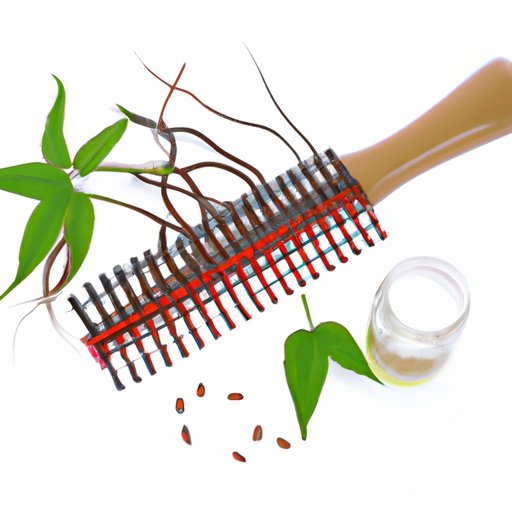
I. Introduction
Having healthy hair is a fundamental aspect of our appearance, and being confident with our hair can boost our overall self-esteem. However, with all the environmentally damaging pollutants and stress that we put our hair through, it’s not uncommon to experience hair damage. This article will provide some insights into how to repair damaged hair, explaining some common factors that contribute to hair damage, and give an overview of what you can expect the article to cover.
II. 5 Home Remedies to Fix Damaged Hair
Natural remedies are inexpensive and a great way to repair hair damage. In this section, we’ll discuss five effective remedies for treating hair damage that utilizes natural products:
- Avocado and coconut oil masks: This remedy is good for dry and unruly hair. Mix an avocado and two tablespoons of coconut oil and apply to the hair from root to tip. Leave it on for 30 mins and rinse with cold water.
- Apple cider vinegar rinse: Apple cider vinegar is great for removing build-up from hair, and it also helps to restore its shine. Mix 1/4 cup of vinegar with water and apply it to your hair after shampooing. Leave it on for a few minutes and rinse it off with tepid water.
- Aloe vera gel treatment: Aloe vera can soothe a dry or irritated scalp and restore hair strength. Mix an aloe vera leaf with four tablespoons of coconut oil and apply it to your hair. Leave it on for 20 minutes and rinse it off with cool water.
- Honey and olive oil hair mask: This remedy is great for moisturizing dry and frizzy hair. Mix an equal amount of honey and olive oil and apply it to your hair. Leave it for 30 minutes before rinsing it off with warm water.
- Drinking enough water and maintaining a healthy diet: Drinking water and eating a balanced diet filled with vitamins and minerals can work wonders for hair repair.
III. The Ultimate Guide to Hair Care Products for Damaged Hair
Choosing the right hair care products is essential for repairing damaged hair. This section will provide tips for how to choose the best shampoos, conditioners, and styling products, based on different hair types and damage levels. Some specific product recommendations include:
- Shea Moisture Jamaican Black Castor Oil Shampoo: This shampoo helps repair damaged hair with castor oil and shea butter, two ingredients that are great for boosting hair health.
- It’s a 10 Miracle Leave-In Conditioner: This leave-in conditioner helps to protect hair from heat and other environmental stressors while also detangling and adding shine.
- Living Proof Restore Instant Repair: This treatment helps to strengthen hair while also smoothing out damage. Perfect for those who have issues with split ends and breakage.
IV. How to Trim Damaged Hair at Home
Regular trimming is essential for maintaining healthy hair, and in this section, we’ll provide step-by-step instructions on how to identify and cut split ends using hair shears. One technique is to twist sections of hair and trim the ends that are sticking out. Another technique is to use a wooden comb to comb the hair out and then cut off any damaged ends.
V. Protective Hairstyles to Repair Damaged Hair
Protective hairstyles cover up the fragile ends of the hair to minimize further damage and promote healthy hair growth. Some protective hairstyles include:
- Braids: With this style, the hair is braided into thin strands and can be styled into different designs and lengths to suit the wearer’s preference.
- Twists: Similar to braids, twists involve twisting the hair into thin strands. It is an easy style that can be done at home and is a great protective style for natural hair.
- Buns: This style is great for those who have natural hair or those with hair that has been straightened. It keeps the ends tucked in so they don’t get damaged by the environment.
- Ponytails: This is a good option for those with long hair. It keeps hair off the neck and helps protect the ends from further damage.
VI. The Dos and Don’ts of Dyeing Damaged Hair
Dyeing hair is a common process that hair enthusiasts use to change their look. However, it can contribute to further hair damage if not done correctly. Here are some tips to follow:
- Choosing a gentle hair dye:Avoid harsh hair dyes that contain damaging chemicals. Opt for hair dyes that use gentle ingredients to avoid further damage to your hair.
- Wait for hair to recover: It’s recommended to wait until the hair is fully recovered before dyeing it.
- Avoid excessive heat styling: Using a flat iron, curling iron or dryer should be avoided when you’re doing hair coloring, as applying heat to color-treated hair can cause additional breakage and damage.
VII. The Science of Hair Damage and Repair
Hair science is complex, and understanding how hair absorbs and loses moisture is important for repairing damaged hair. Several types of hair damage can cause adverse effects on the hair shaft, such as weathering, mechanical damage and cuticle removal. This section explains how hair repair products work on a molecular level.
VIII. Conclusion
Our hair is a somewhat integral part of our personal identity, so keeping it healthy is a priority for many of us. In this article, we’ve explored various remedies for repairing damaged hair, shared some dos and don’ts when it comes to coloring hair, provided recommendations on the perfect hair care products for different damage levels, and talked about the science behind hair damage and repair. There is no shortcut to restoring your hair health, and most importantly, consistent care and maintenance are crucial for obtaining successful results. We hope these tips will help you achieve the healthy, gorgeous hair you deserve.
Final piece of advice: Remember to be gentle with your hair and not to over-style it to avoid further damage.




